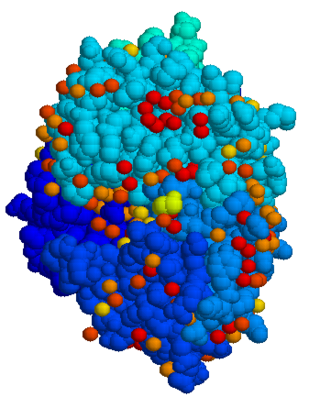
The National Institutes of Health, commonly referred to as NIH, is the primary agency of the United States government responsible for biomedical and public health research. It was founded in the late 1880s and is now part of the United States Department of Health and Human Services. Many NIH facilities are located in Bethesda, Maryland, and other nearby suburbs of the Washington metropolitan area, with other primary facilities in the Research Triangle Park in North Carolina and smaller satellite facilities located around the United States. The NIH conducts its own scientific research through the NIH Intramural Research Program (IRP) and provides major biomedical research funding to non-NIH research facilities through its Extramural Research Program.
The National Institute of Arthritis and Musculoskeletal and Skin Diseases (NIAMS) is one of the institutes and centers that make up the National Institutes of Health, an agency of the United States Department of Health and Human Services (HHS).
The National Institute of Allergy and Infectious Diseases is one of the 27 institutes and centers that make up the National Institutes of Health (NIH), an agency of the United States Department of Health and Human Services (HHS). NIAID's mission is to conduct basic and applied research to better understand, treat, and prevent infectious, immunologic, and allergic diseases.
Translational medicine develops the clinical practice applications of the basic science aspects of the biomedical sciences; that is, it translates basic science to applied science in medical practice. It is defined by the European Society for Translational Medicine as "an interdisciplinary branch of the biomedical field supported by three main pillars: benchside, bedside, and community". The goal of translational medicine is to combine disciplines, resources, expertise, and techniques within these pillars to promote enhancements in prevention, diagnosis, and therapies. Accordingly, translational medicine is a highly interdisciplinary field, the primary goal of which is to coalesce assets of various natures within the individual pillars in order to improve the global healthcare system significantly.

Hepatoerythropoietic porphyria is a very rare form of hepatic porphyria caused by a disorder in both genes which code Uroporphyrinogen III decarboxylase (UROD).
The National Center for Research Resources (NCRR) was a center within the National Institutes of Health, a United States government agency. NCRR provided funding to laboratory scientists and researchers for facilities and tools in the goal of curing and treating diseases.
Translational research is research aimed at translating (converting) results in basic research into results that directly benefit humans. The term is used in science and technology, especially in biology and medical science. As such, translational research forms a subset of applied research.
The National Health Council (NHC) is a nonprofit association of health organizations.

The Vaccine Research Center (VRC), is an intramural division of the National Institute of Allergy and Infectious Diseases (NIAID), part of the National Institutes of Health (NIH), US Department of Health and Human Services (HHS). The mission of the VRC is to discover and develop both vaccines and antibody-based products that target infectious diseases.

The NIH Clinical Center is a hospital solely dedicated to clinical research at the National Institutes of Health campus in Bethesda, Maryland. The Clinical Center, known as Building 10, consists of the original part of the hospital, the Warren Grant Magnuson Clinical Center, and the newest addition, the Mark O. Hatfield Clinical Research Center. The two parts are connected to form one large building.

The NIH Intramural Research Program (IRP) is the internal research program of the National Institutes of Health (NIH), known for its synergistic approach to biomedical science. With 1,200 Principal Investigators and over 4,000 Postdoctoral Fellows conducting basic, translational, and clinical research, the NIH Intramural Research Program is the largest biomedical research institution on earth. The unique funding environment of the IRP facilitates opportunities to conduct both long-term and high-impact science that would otherwise be difficult to undertake. With rigorous external reviews ensuring that only the most outstanding research secures funding, the IRP is responsible for many scientific accomplishments, including the discovery of fluoride to prevent tooth decay, the use of lithium to manage bipolar disorder, and the creation of vaccines against hepatitis, Hemophilus influenzae (Hib), and human papillomavirus (HPV). In addition, the IRP has also produced or trained 21 Nobel Prize-winning scientists.
The Rare Diseases Clinical Research Network (RDCRN) is an initiative of the US Office of Rare Diseases Research (ORDR). RDCRN is funded by the ORDR, the National Center for Advancing Translational Sciences and collaborating institute centers. The RDCRN is designed to advance medical research on rare diseases by providing support for clinical studies and facilitating collaboration, study enrollment and data sharing. Through the RDCRN consortia, physician scientists and their multidisciplinary teams work together with patient advocacy groups to study more than 200 rare diseases at sites across the nation.
The Rare Diseases Clinical Research Network (RDCRN) Contact Registry is a patient contact registry started in 2004 and sponsored by the National Institutes of Health (NIH). The RDCRN Contact Registry collects and stores the contact information of people who want to participate in RDCRN-sponsored research or learn more about RDCRN research. It connects patients with researchers in order to advance rare disease research.

The Rare Disease Act of 2002 is a law passed in the United States that establishes the statutory authorization for the Office of Rare Diseases as a federal entity able to recommend a national research agenda, coordinate research, and provide educational activities for researchers.
A physician-scientist is traditionally a holder of a medical degree and a doctor of philosophy also known as an MD-PhD. Compared to other clinicians, physician-scientists invest significant time and professional effort in scientific research and spend correspondingly less time in direct clinical practice with ratios of research to clinical time ranging from 50/50 to 80/20. Physician-scientists are often employed by academic or research institutions where they drive innovation across a wide range of medical specialties and may also use their extensive training to focus their clinical practices on specialized patient populations, such as those with rare genetic diseases or cancers. Although they are a minority of both practicing physicians and active research scientists, physician-scientists are often cited as playing a critical role in translational medicine and clinical research by adapting biomedical research findings to health care applications. Over time, the term physician scientist has expanded to holders of other clinical degrees—such as nurses, dentists, and veterinarians— who are also included by the United States National Institutes of Health in its studies of the physician-scientist workforce (PSW).

The Office of Rare Diseases Research is a division of the US National Center for Advancing Translational Sciences (NCATS) that oversees the Rare Diseases Clinical Research Network and Genetic and Rare Diseases Information Center.

Marshall L. Summar is an American physician, clinical geneticist and academic specializing in the field of genetics and rare disease. He is board-certified in pediatrics, biochemical genetics and clinical genetics. He is best known for his work in caring for children with rare genetic diseases.

Melissa Anne Haendel is an American bioinformaticist who is the Chief Research Informatics Officer of the Anschutz Medical Campus of the University of Colorado as well as a Professor of Biochemistry and Molecular Genetics and the Marsico Chair in Data Science. She serves as Director of the Center for Data to Health (CD2H). Her research makes use of data to improve the discovery and diagnosis of diseases. During the COVID-19 pandemic, Haendel joined with the National Institutes of Health to launch the National COVID Cohort Collaborative (N3C), which looks to identify the risk factors that can predict severity of disease outcome and help to identify treatments.

Joni L. Rutter is an American geneticist and director of the National Center for Advancing Translational Sciences (NCATS). Rutter was previously director of the scientific programs in the All of Us initiative and served as the neuroscience and behavior division director at the National Institute on Drug Abuse. Her scientific experience includes clinical research in human genetics and environmental risk factors focusing on the fields of cancer and addiction.

Kathy Lynn Hudson is an American microbiologist specializing in science policy. She was the deputy director for science, outreach, and policy at the National Institutes of Health from October 2010 to January 2017. Hudson assisted in the creation and launch of All of Us, the BRAIN initiative, and the National Center for Advancing Translational Sciences. She founded the Genetics and Public Policy Center at Johns Hopkins University in 2002. Hudson is an advocate for women in science.












